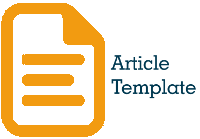WEBSITE USABILITY EVALUATION USING HEURISTIC EVALUATION METHOD (STUDY CASE : XYZ CITY PUBLIC WORKS OFFICE)
DOI:
https://doi.org/10.35457/antivirus.v15i2.1553Keywords:
heuristic evaluation, Interface, User Experience, User InterfaceAbstract
The very rapid development of information technology in this era allows most people to access various kinds of information in other parts of the world through a network called the internet. However, to access this information, other things are needed, such as a website address that contains the desired information and an interface to display the information desired by the user. Every user must have a different experience when interacting with an interface, this is called the user experience. By knowing what experiences are experienced by users, developers can find out the various weaknesses and strengths that exist on the website created so that developers can update their website according to user needs. The evaluation carried out in this study uses the heuristic evaluation method, where this evaluation method is carried out to find usability problems that exist on the XYZ City Public Works Office website by referring to 10 heuristic principles to produce effective and efficient improvements. The evaluation stages carried out in this study are establishing requirements, design alternatives, prototyping, and conclusions. The results of this study were found 17 problems and 17 recommendations for improvements made based on the discovery of problems that exist in the object of this study even though there are 2 principles that have no problems in it. Most problems were found on the principles of flexibility and efficiency of use. The problems that have severity rating 4 are 3 problems, severity rating 3 is 4 problems, severity rating 2 is 7 problems and severity rating 0 is 1 problem.
Downloads
References
G. P. Riyanto, "Kompas," PT. Kompas Cyber Media, 23 February 2021. [Online]. Available: https://tekno.kompas.com/read/2021/02/23/16100057/jumlah-pengguna-internet-indonesia-2021-tembus-202-juta#:~:text=KOMPAS.com%20%2D%20Pengguna%20internet%20di,dibandingkan%20pada%20Januari%202020%20lalu. [Accessed 1 June 2021].
P. Krisnayani, I. K. R. Arthana and I. G. M. Darmawiguna, "Analisa Usability Pada Website UNDIKSHA Dengan Menggunakan Metode Heuristic Evaluation," Kumpulan Artikel Mahasiswa Pendidikan Teknik Informatika (KARMAPATI), vol. 5, no. 2, 2016.
I. G. A. A. D. Indrayani, I. P. A. Bayupati and I. M. S. Putra, "Analisis Usability Aplikasi iBadung Menggunakan Heuristic Evaluation Method," Jurnal Ilmiah Merpati, vol. 8, no. 2, pp. 89-100, 2020.
U. Ependi, T. B. Kurniawan and F. Panjaitan, "System Usability Scale VS Heuristic Evaluation: A Review," Simetris Jurnal Teknik Mesin Elektro dan Ilmu Komputer, vol. 10, pp. 65-74, 2019.
D. P. Umum, "Dinas Pekerjaan Umum Kota XYZ," 1 June 2021. [Online]. Available: http://dpu.xyz.go.id/polling. [Accessed 1 June 2021].
A. P. Hendradewa, "Perbandingan Metode Evaluasi Usability (Studi Kasus : Penggunaan Perangkat Smartphone)," Teknoin, vol. 23, no. 1, pp. 09-18, 2017.
M. G. L. Putra, N. R. Sabilla and S. R. Natasia, "Evaluasi Usability Website Berita Online Prokal.Co Menggunakan Evaluasi Heuristic dan Webuse," Jurnal Teknologi Informasi dan Ilmu Komputer (JTIIK), vol. 7, no. 5, pp. 911-922, 2020.
A. Koohang, "Expanding the Concept of Usability," Informing Science Journal, vol. 7, 2004.
J. Nielsen and R. Molich, "Heuristic Evaluation Of User Interfaces," in CHI '90: Proceedings of the SIGCHI Conference on Human Factors in Computing Systems, Seattle, 1990.
Y. M. Geasela, P. Ranting and J. F. Andry, "Analisis User Interface terhadap Website Berbasis E-Learning dengan Metode Heuristic Evaluation," Jurnal INFORMATIKA, vol. 5, no. 2, pp. 270-277, 2018.
J. Ardhiyani and A. M. Bachtiar, "Analisis User Interface Media Pembelajaran Pengenalan Kosakata Untuk Anak Tunarungu," Jurnal Ilmiah Komputer dan Informatika (KOMPUTA).
T. K. Ahsyar and D. Afani, "Evaluasi Usability Website Berita Online Menggunakan Metode Heuristic Evaluation," Jurnal Ilmiah Rekayasa dan Manajemen Sistem Informasi, vol. 5, pp. 34-41, 2019.
Downloads
Published
Issue
Section
License
Authors who publish with this journal agree to the following terms:
- Copyright on any article is retained by the author(s).
- Author grant the journal, right of first publication with the work simultaneously licensed under a Creative Commons Attribution License that allows others to share the work with an acknowledgement of the work’s authorship and initial publication in this journal.
- Authors are able to enter into separate, additional contractual arrangements for the non-exclusive distribution of the journal’s published version of the work (e.g., post it to an institutional repository or publish it in a book), with an acknowledgement of its initial publication in this journal.
- Authors are permitted and encouraged to post their work online (e.g., in institutional repositories or on their website) prior to and during the submission process, as it can lead to productive exchanges, as well as earlier and greater citation of published work.
- The article and any associated published material is distributed under the Creative Commons Attribution-ShareAlike 4.0 International License











